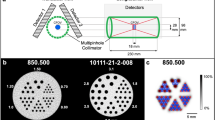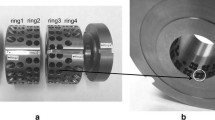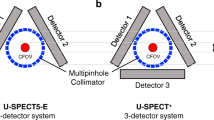Abstract
Purpose
We assessed the quantitation accuracy of small animal pinhole single photon emission computed tomography (SPECT) under the current preclinical settings, where image compensations are not routinely applied.
Procedures
The effects of several common image-degrading factors and imaging parameters on quantitation accuracy were evaluated using Monte-Carlo simulation methods. Typical preclinical imaging configurations were modeled, and quantitative analyses were performed based on image reconstructions without compensating for attenuation, scatter, and limited system resolution.
Results
Using mouse-sized phantom studies as examples, attenuation effects alone degraded quantitation accuracy by up to −18% (Tc-99m or In-111) or −41% (I-125). The inclusion of scatter effects changed the above numbers to −12% (Tc-99m or In-111) and −21% (I-125), respectively, indicating the significance of scatter in quantitative I-125 imaging. Region-of-interest (ROI) definitions have greater impacts on regional quantitation accuracy for small sphere sources as compared to attenuation and scatter effects. For the same ROI, SPECT acquisitions using pinhole apertures of different sizes could significantly affect the outcome, whereas the use of different radii-of-rotation yielded negligible differences in quantitation accuracy for the imaging configurations simulated.
Conclusions
We have systematically quantified the influence of several factors affecting the quantitation accuracy of small animal pinhole SPECT. In order to consistently achieve accurate quantitation within 5% of the truth, comprehensive image compensation methods are needed.






Similar content being viewed by others
References
Weissleder R, Mahmood U (2001) Molecular imaging. Radiology 219:316–33. May
Pomper MG (2001) Molecular imaging: an overview. Acad Radiol 8:1141–53. Nov
Pomper MG (2005) Translational molecular imaging for cancer. Canc Imag 5:S16–26. Spec No A
Beekman F, van der Have F (2007) The pinhole: gateway to ultra-high-resolution three-dimensional radionuclide imaging. Eur J Nucl Med Mol Imaging 34:151–161. Feb
Meikle SR, Kench P, Kassiou M, Banati RB (2005) Small animal SPECT and its place in the matrix of molecular imaging technologies. Phys Med Biol 50:R45–R61. Nov 21
Acton PD, Choi SR, Plossl K, Kung HF (2002) Quantification of dopamine transporters in the mouse brain using ultra-high resolution single-photon emission tomography. Eur J Nucl Med Mol Imaging 29:691–698. May
Acton PD, Thomas D, Zhou R (2006) Quantitative imaging of myocardial infarct in rats with high resolution pinhole SPECT. Int J Cardiovasc Imaging 22:429–434. Jun
Alvarez-Fischer D, Blessmann G, Trosowski C et al (2007) Quantitative [I-123]FP-CIT pinhole SPECT imaging predicts striatal dopamine levels, but not number of nigral neurons in different mouse models of Parkinson’s disease. Neuroimage 38:5–12. Oct 15
Liu ZL, Kastis GA, Stevenson GD et al (2002) Quantitative analysis of acute myocardial infarct in rat hearts with ischemia–reperfusion using a high-resolution stationary SPECT system. J Nucl Med 43:933–939. Jul
Tsui BMW, Frey EC, Zhao X, Lalush DS, Johnston RE, Mccartney WH (1994) The importance and implementation of accurate 3d compensation methods for quantitative SPECT. Phys Med Biol 39:509–530. Mar
Tsui BMW, Zhao XD, Frey EC, Mccartney WH (1994) Quantitative single-photon emission computed-tomography—basics and clinical considerations. Semin Nucl Med 24:38–65. Jan
Deloar HM, Watabe H, Aoi T, Iida H (2003) Evaluation of penetration and scattering components in conventional pinhole SPECT: phantom studies using Monte Carlo simulation. Phys Med Biol 48:995–1008. Apr 21
Li J, Jaszczak RJ, Coleman RE (1995) Quantitative small field-of-view pinhole spect imaging—initial evaluation. IEEE Trans Nucl Sci 42:1109–1113. Aug
Hwang AB, Taylor CC, VanBrocklin HF, Dae MW, Hasegawa BH (2006) Attenuation correction of small animal SPECT images acquired with I-125-iodorotenone. IEEE Trans Nucl Sci 53:1213–1220. Jun
Chen C-L, Wang Y, Lee JJS, Tsui BMW (2008) Integration of SimSET photon history generator in GATE for efficient Monte Carlo simulations of Pinhole SPECT. Med Phys 35:3278–3284. July
Harrison RL, Haynor DR, Gillispie SB, Vannoy SD, Kaplan MS, Lewellen TK (1993) A public-domain simulation system for emission tomography-photon tracking through heterogeneous attenuation using importance sampling. J Nucl Med 34:P60–P60. May
Jan S, Santin G, Strul D et al (2004) GATE: a simulation toolkit for PET and SPECT. Phys Med Biol 49:4543–4561. Oct 7
Wang YC, Tsui BMW (2007) Pinhole SPECT with different data acquisition geometries: Usefulness of unified projection operators in homogeneous coordinates. IEEE Trans Med Imag IEEE 26:298–308. Mar
Segars WP, Tsui BMW, Frey EC, Johnson GA, Berr SS (2004) Development of a 4-D digital mouse phantom for molecular imaging research. Mol Imag Biol 6:149–159. May–Jun
Acknowledgments
The authors would like to thank Drs. Eric Frey and Yong Du (Johns Hopkins Univ.) for their valuable suggestions. Special thanks go to Martin Stump for carefully editing the manuscript. This project is partially supported by the US Public Health Service Grants EB168 and EB1558.
Author information
Authors and Affiliations
Corresponding author
Additional information
Significance: We assessed the quantitation accuracy of small animal pinhole SPECT, providing reference information for the current preclinical studies.
Rights and permissions
About this article
Cite this article
Chen, CL., Wang, Y., Lee, J.J.S. et al. Toward Quantitative Small Animal Pinhole SPECT: Assessment of Quantitation Accuracy Prior to Image Compensations. Mol Imaging Biol 11, 195–203 (2009). https://doi.org/10.1007/s11307-008-0181-0
Received:
Revised:
Accepted:
Published:
Issue Date:
DOI: https://doi.org/10.1007/s11307-008-0181-0




